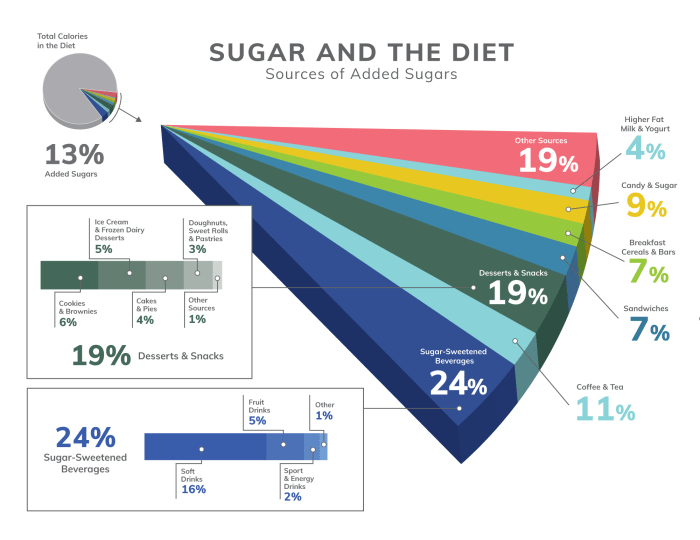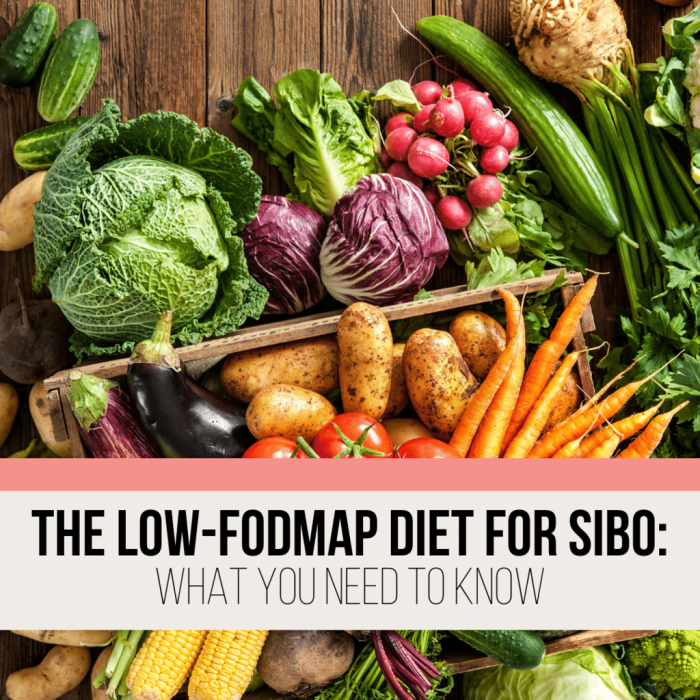What is the FODMAP diet? It’s a fascinating dietary approach designed to help manage digestive issues. This guide explores the principles, foods to avoid, and strategies for managing a low FODMAP lifestyle. From understanding the different types of FODMAPs to crafting personalized meal plans, we’ll cover everything you need to know about this dietary strategy.
The FODMAP diet focuses on reducing fermentable carbohydrates that can trigger digestive symptoms like bloating, gas, and diarrhea in some individuals. By understanding the science behind these foods and their effects, you can gain a deeper understanding of how this diet can impact your well-being.
Introduction to the FODMAP Diet
The FODMAP diet is a dietary approach used to manage symptoms associated with irritable bowel syndrome (IBS) and other digestive issues. It involves temporarily reducing the intake of certain types of carbohydrates called FODMAPs, which are poorly absorbed by the small intestine and can cause digestive distress in sensitive individuals. This approach aims to identify and manage triggers that lead to symptoms like bloating, gas, abdominal pain, and diarrhea.The fundamental principle behind the low FODMAP diet is to minimize the consumption of fermentable carbohydrates that can be difficult for the digestive system to process.
This reduction in FODMAP intake aims to decrease the amount of food entering the large intestine that can cause excessive fermentation and gas production, thereby easing digestive discomfort. The goal isn’t to eliminate these foods permanently, but rather to identify potential triggers and find a balance that alleviates symptoms.
Categories of FODMAPs
FODMAPs are a group of short-chain carbohydrates that are poorly absorbed in the small intestine. They are categorized into five types: fructose, galactose, lactose, fructans, and polyols. Each type contributes to digestive issues in different ways.
FODMAP Examples and Potential Symptoms
The following table Artikels examples of foods containing each FODMAP type, potential symptoms that their consumption may trigger, and general advice for managing them on a low FODMAP diet.
| FODMAP Type | Examples | Potential Symptoms | General Advice for Low FODMAP Diet |
|---|---|---|---|
| Fructose | Honey, fruit juices, some fruits (apples, pears, mangoes), certain vegetables (asparagus, artichokes), and high-fructose corn syrup | Bloating, gas, abdominal cramps, diarrhea | Limit or avoid high-fructose foods. Opt for moderate portions of lower-fructose fruits and vegetables. |
| Galactose | Dairy products (milk, yogurt, ice cream), certain vegetables (broccoli, cabbage) | Bloating, gas, abdominal cramps, diarrhea | Reduce dairy intake and carefully monitor consumption of galactose-containing vegetables. Consider lactose-free alternatives when possible. |
| Lactose | Milk, yogurt, cheese, ice cream, certain baked goods | Bloating, gas, abdominal cramps, diarrhea | Reduce or eliminate dairy products. Opt for lactose-free alternatives or low-lactose options. |
| Fructans | Wheat, rye, barley, some fruits (bananas, stone fruits), and many root vegetables (onions, garlic, leeks) | Bloating, gas, abdominal cramps, diarrhea | Avoid high-fructan foods. Choose lower-fructan alternatives or limit portions. |
| Polyols | Certain fruits (cherries, plums, apricots, peaches, and some berries), some vegetables, and sugar alcohols (e.g., sorbitol, mannitol, xylitol) | Bloating, gas, abdominal cramps, diarrhea | Minimize or avoid high-polyol foods. Check food labels for sugar alcohols. |
Understanding FODMAPs
The FODMAP diet is centered around reducing fermentable carbohydrates called FODMAPs. These compounds, naturally present in various foods, can trigger digestive issues in some individuals. Understanding the different types of FODMAPs and their effects is crucial for navigating the diet effectively. By knowing which FODMAPs are most problematic for you, you can make informed choices about the foods you eat.FODMAPs are short-chain carbohydrates that are poorly absorbed in the small intestine.
Instead, they travel to the large intestine where bacteria ferment them. This fermentation process produces gases and other byproducts that can lead to symptoms like bloating, gas, abdominal pain, and diarrhea in susceptible individuals. Understanding the types of FODMAPs and their individual characteristics is key to managing these symptoms.
Types of FODMAPs
FODMAPs are categorized into four main groups: fructose, galactose, lactose, and fructans, as well as polyols. Each type has unique characteristics and affects individuals differently.
The FODMAP diet is all about limiting certain fermentable carbohydrates to ease digestive distress. It’s a common approach for managing irritable bowel syndrome (IBS), but it can feel restrictive. Interestingly, the principles of transparency and inclusivity, so vital for fair labor practices, can be applied to the way we approach dietary challenges like this too. For example, kickstarter unionizing union representation inclusivity transparency tech us crowdfunding highlights how these concepts are essential for fostering a better work environment.
Ultimately, the FODMAP diet is about finding a balance that works for your individual needs and overall well-being.
Fructose, What is the fodmap diet
Fructose, a simple sugar, is found in fruits, honey, and some vegetables. It is often readily absorbed in the small intestine, but higher amounts can overwhelm the absorption capacity, leading to issues in the large intestine.
Galactose
Galactose, another simple sugar, is often part of lactose. Its impact on digestion is often similar to fructose, with excess amounts potentially causing issues in the large intestine.
Lactose
Lactose, a disaccharide found in milk and dairy products, is a common source of digestive problems for those with lactose intolerance. Individuals with lactose intolerance lack the enzyme lactase, which is needed to break down lactose, leading to its fermentation in the large intestine.
Fructans
Fructans are a type of prebiotic fiber found in wheat, rye, onions, and garlic. They are slowly digested, and the bacterial fermentation of fructans in the large intestine can produce significant gas and other symptoms.
Polyols
Polyols are sugar alcohols found in many fruits, vegetables, and sugar-free foods. They are poorly absorbed in the small intestine, resulting in significant fermentation and digestive discomfort in some individuals. This category includes sorbitol, mannitol, xylitol, and maltitol.
The FODMAP diet, essentially, is a way to manage digestive issues by avoiding certain fermentable carbohydrates. It’s all about tweaking your diet to see if you can ease symptoms like bloating and gas. While I was exploring the world of cutting-edge tech, like trying out Meta’s Orion AR glasses, I wore Meta’s Orion AR glasses – a wireless taste of a neural future , it made me think about how our relationship with food and technology can be so intertwined.
Ultimately, the FODMAP diet is a fascinating approach to finding dietary harmony.
Effects of Different FODMAPs
The effects of different FODMAPs on individuals vary. While some people may tolerate certain types better than others, the overall impact on digestion depends on individual factors like the amount consumed and the specific gut microbiome. Some individuals may be more sensitive to fructose or fructans, while others may experience significant symptoms with lactose or polyols.
FODMAPs, Sources, and Symptoms
| FODMAP Type | Common Sources | Typical Symptoms |
|---|---|---|
| Fructose | Fruits (apples, pears, mangoes), honey, some vegetables | Bloating, gas, abdominal pain, diarrhea |
| Galactose | Milk, dairy products | Bloating, gas, abdominal pain, diarrhea |
| Lactose | Milk, yogurt, cheese | Bloating, gas, abdominal pain, diarrhea |
| Fructans | Wheat, rye, barley, onions, garlic, asparagus | Bloating, gas, abdominal pain, diarrhea |
| Polyols | Fruits (some berries, stone fruits), sugar-free foods, vegetables | Bloating, gas, abdominal pain, diarrhea |
Common Food Sources and Potential Adverse Effects
| Food Source | FODMAP Type(s) | Potential Adverse Effects |
|---|---|---|
| Wheat bread | Fructans | Bloating, gas, abdominal pain, diarrhea |
| Onions | Fructans | Bloating, gas, abdominal pain, diarrhea |
| Milk | Lactose | Bloating, gas, abdominal pain, diarrhea |
| Apples | Fructose | Bloating, gas, abdominal pain, diarrhea |
| Dried fruits | Fructose, polyols | Bloating, gas, abdominal pain, diarrhea |
The Low FODMAP Diet
The low FODMAP diet is a therapeutic approach designed to help individuals manage symptoms associated with irritable bowel syndrome (IBS) and other digestive disorders. It works by temporarily restricting certain types of fermentable carbohydrates, known as FODMAPs, which can trigger digestive distress in sensitive individuals. This approach focuses on identifying and eliminating foods that exacerbate symptoms, allowing the gut to heal and function more effectively.
Understanding the specifics of this dietary approach is crucial for successful implementation.
Dietary Restrictions of the Low FODMAP Diet
This dietary approach necessitates the temporary elimination of high FODMAP foods. This initial phase involves careful planning and preparation to ensure nutritional adequacy. A thorough understanding of FODMAPs is essential for successfully navigating this phase.
- FODMAP categories are crucial to understand. These include fructose, lactose, fructans, galactans, and polyols. Each category encompasses various food types, requiring meticulous attention to ingredient lists and food labels. It’s essential to be mindful of hidden FODMAPs in processed foods, sauces, and even some medications.
- Food labels become critical tools. Reading food labels for ingredients containing FODMAPs is vital to avoid unintended consumption. Pay close attention to hidden sources of FODMAPs, such as those found in condiments, sauces, and even some medications.
Foods High in FODMAPs
Identifying high FODMAP foods is a key element of the diet. This necessitates a meticulous review of potential sources. The goal is to recognize high-FODMAP foods and substitute them with low-FODMAP alternatives.
- Fruits such as apples, pears, and mangoes are often high in fructose. Grapes, and watermelon are also in this category. Be aware of the presence of fructose in many fruit juices and dried fruits.
- Vegetables like onions, garlic, and asparagus contain fructans, contributing to their high FODMAP content. Other vegetables, such as cabbage and broccoli, can also be high in FODMAPs. It is essential to check specific vegetables.
- Dairy products including milk, yogurt, and ice cream contain lactose. This makes it crucial to pay attention to the lactose content in dairy products.
- Legumes such as beans, lentils, and peas are often high in fructans. It is essential to check the FODMAP content of different types of legumes.
- Grains such as wheat, rye, and barley contain fructans, which make them high in FODMAPs. It is crucial to identify different types of grains.
- Other foods include certain sweeteners (like honey and agave), some artificial sweeteners, and many processed foods.
Gradual Reintroduction of High FODMAP Foods
After the elimination phase, a gradual reintroduction of high FODMAP foods is crucial. This approach allows for monitoring of individual responses.
- Controlled reintroduction helps track potential triggers. Begin with small amounts of a single high FODMAP food. Observe your body’s reaction, noting any symptoms that arise.
- Symptom monitoring is paramount. Keep a detailed food diary, noting what you eat and any resulting digestive discomfort. This will help identify foods that may trigger symptoms.
- Individual tolerance varies. Some individuals may tolerate higher FODMAP levels more readily than others. It’s essential to adjust the reintroduction process based on your own individual needs.
Low FODMAP vs. High FODMAP Food Comparison
The following table provides a comparison of low FODMAP options with high FODMAP alternatives for common foods.
| Food | Low FODMAP Alternative | High FODMAP Alternative |
|---|---|---|
| Milk | Almond milk, soy milk | Cow’s milk, goat’s milk |
| Onions | Leeks, shallots | Red onions, white onions |
| Fruits | Bananas, berries, watermelon | Apples, pears, mangoes, grapes |
| Vegetables | Cauliflower, zucchini, carrots | Onions, garlic, asparagus |
| Grains | Rice, quinoa, oats | Wheat, rye, barley |
Managing Symptoms and Potential Issues
The low FODMAP diet, while effective for many, can present challenges. Understanding potential side effects and how to manage them is crucial for successful and sustainable adherence. Careful monitoring and a supportive approach are essential for navigating these potential difficulties.The diet’s restrictive nature can sometimes lead to nutritional deficiencies if not carefully planned. This is where the importance of professional guidance becomes paramount.
Properly structured meal plans, tailored to individual needs, help to mitigate these risks.
Potential Side Effects of the Diet
The low FODMAP diet, though beneficial for many, can cause some side effects. These are often temporary and manageable with proper planning and guidance. Some individuals might experience digestive discomfort, such as bloating, gas, or abdominal cramps. Nutritional deficiencies are also a potential concern if the diet isn’t meticulously planned. It’s crucial to remember that individual experiences can vary significantly.
Challenges of the Diet
The strict nature of the low FODMAP diet can pose challenges. Adapting to a new way of eating can be difficult, especially for individuals who enjoy a wide variety of foods. Finding suitable substitutes and meal options can be time-consuming and require significant effort. Maintaining the diet long-term can be mentally taxing and might lead to feelings of social isolation if not addressed proactively.
Importance of Professional Guidance
A registered dietitian or healthcare professional plays a crucial role in managing the low FODMAP diet. Their expertise helps individuals create balanced meal plans that address their specific nutritional needs while adhering to the diet’s restrictions. A healthcare professional can identify potential risks and complications early on, offering tailored advice and support. They can also help individuals manage any nutritional deficiencies that may arise.
Proper guidance ensures that the diet is followed safely and effectively.
Potential Risks and Complications of a Very Restrictive Diet
Very restrictive diets, like the low FODMAP diet when not properly managed, can potentially lead to nutritional deficiencies. For example, if someone drastically cuts out entire food groups without adequate planning, they might experience a shortage of vital vitamins and minerals. A lack of variety in the diet might affect overall health and well-being, and can impact mood.
The FODMAP diet is all about limiting certain fermentable carbohydrates. It’s a bit like a food detective mission to see how your body reacts to different foods. While you’re trying to figure out what’s best for your gut, it’s also interesting to see how tech companies are doing, like Spotify raising another 500 million here. This is all about managing symptoms for many, so it’s a big deal for those with digestive sensitivities.
Ultimately, the diet aims to reduce symptoms like bloating and gas.
This is why consulting a healthcare professional before embarking on a restrictive diet like the low FODMAP diet is crucial.
Managing Side Effects: A Guide
| Potential Side Effect | Management Strategies |
|---|---|
| Bloating and Gas | Slowly reintroduce FODMAPs under professional guidance. Increase intake of fiber-rich foods (slowly and in small portions). Hydration is key. |
| Nutrient Deficiencies | Work with a registered dietitian to create a balanced meal plan. Ensure adequate intake of vitamins and minerals through supplements or fortified foods, if necessary. |
| Difficulty Maintaining Diet Long-Term | Focus on creating sustainable habits. Incorporate enjoyable aspects into the diet, such as finding healthy alternatives to favorite dishes. Find social support groups or online communities. |
| Social Isolation | Engage in activities with friends and family that don’t involve food. Explore social groups focused on dietary needs, such as support groups for those with IBS. Prioritize open communication with loved ones. |
Food Alternatives and Substitutions

Navigating the low FODMAP world can feel like a culinary puzzle. But with a little know-how, you can swap out high FODMAP foods for delicious, satisfying alternatives without sacrificing flavor or nutrition. This section will guide you through suitable substitutions, offering practical examples and recipes to make the transition smoother.This section focuses on providing practical strategies for replacing high FODMAP ingredients with low FODMAP options.
It’s designed to empower you to confidently create delicious and satisfying meals and snacks while managing your symptoms effectively.
Appropriate Substitutions for High FODMAP Foods
Replacing high FODMAP ingredients is key to a successful low FODMAP diet. Careful selection of substitutes ensures you maintain a balanced diet while managing symptoms. Knowing the appropriate low FODMAP alternatives is crucial for successful symptom management.
- Instead of wheat-based breads, pastas, and cereals, opt for rice-based products, quinoa, or almond flour-based alternatives. These offer similar textures and can be incorporated into many recipes without much modification.
- When fruits are high FODMAP, consider using low FODMAP options like berries, watermelon, or papayas. These provide sweetness and vitamins without triggering symptoms.
- For high FODMAP vegetables like onions, garlic, and asparagus, find low FODMAP substitutes such as zucchini, bell peppers, and spinach. These offer similar nutritional value and can be used in many recipes.
- Dairy products can be replaced with lactose-free milk alternatives, such as almond milk, soy milk, or coconut milk. Many of these alternatives are readily available and easily incorporated into your diet.
Low FODMAP Alternatives for Common Meals and Snacks
Creating delicious meals and snacks within the low FODMAP guidelines doesn’t have to be challenging. Here are some examples to inspire you:
- Breakfast: Instead of a high FODMAP breakfast cereal, try a bowl of oatmeal made with low FODMAP milk and topped with berries and nuts. This provides a balanced and satisfying start to your day.
- Lunch: Swap a high FODMAP sandwich for a salad featuring low FODMAP vegetables, lean protein, and a light vinaigrette. This offers a fresh and nutritious option.
- Dinner: Instead of a high FODMAP pasta dish, enjoy a chicken stir-fry with low FODMAP vegetables like broccoli and bell peppers. This provides a balanced and satisfying dinner option.
- Snacks: Opt for low FODMAP fruits like berries or a handful of almonds instead of high FODMAP apples or pears. These snacks offer a satisfying and healthy option.
Recipes for Low FODMAP Meals and Snacks
Here are some recipe ideas to get you started:
- Low FODMAP Chicken Stir-Fry: Marinate chicken breast in a ginger-garlic-free sauce. Stir-fry with low FODMAP vegetables like broccoli, carrots, and bell peppers. Serve over brown rice.
- Low FODMAP Berry Parfait: Layer low FODMAP yogurt (or a plant-based alternative) with a mix of berries, and a sprinkle of granola (check for FODMAP content). This is a quick and easy snack.
Modifying Existing Recipes to Make Them Low FODMAP
Many existing recipes can be easily adapted to the low FODMAP diet. Start by identifying the high FODMAP ingredients in the recipe and substituting them with their low FODMAP equivalents. Adjust seasonings as needed to maintain the desired flavor profile.
Table of Common High FODMAP Ingredients and Their Low FODMAP Replacements
| High FODMAP Ingredient | Low FODMAP Replacement |
|---|---|
| Wheat | Rice, Almond Flour, Quinoa |
| Onions | Zucchini, Bell Peppers |
| Garlic | Ginger, Onion Powder |
| Asparagus | Spinach, Broccoli |
| Apples | Berries, Watermelon |
| Dairy Products (High Lactose) | Lactose-free Milk Alternatives |
Long-Term Considerations and Maintenance
Embarking on the low FODMAP diet is a journey, not a sprint. Long-term adherence requires careful planning, understanding, and consistent effort. It’s not about deprivation, but about learning to manage your symptoms and improve your overall well-being through mindful food choices.Maintaining a low FODMAP lifestyle isn’t about following a rigid set of rules forever; it’s about developing sustainable habits and finding a balanced approach to food that supports your health goals.
This includes recognizing that the low FODMAP diet is a tool, not a life sentence.
Importance of Long-Term Dietary Management
Long-term dietary management of FODMAPs is crucial for sustained symptom relief and improved quality of life. Maintaining a low FODMAP diet allows individuals to manage their digestive symptoms effectively and prevent flare-ups, leading to a more stable and comfortable existence. Furthermore, this proactive approach helps prevent long-term health issues that may arise from chronic digestive discomfort.
Strategies for Maintaining a Low FODMAP Lifestyle
Developing consistent strategies is key to long-term adherence. These strategies go beyond simply following a list of foods to avoid. They incorporate mindful eating habits and a proactive approach to food choices.
- Gradual Reintroduction: The process of reintroducing high FODMAP foods, under the guidance of a healthcare professional, is crucial. This controlled approach helps identify individual triggers and allows for adjustments to the diet over time. This cautious approach minimizes the risk of symptom relapse. For example, a person might start with small amounts of lactose and slowly increase their intake while monitoring their symptoms.
- Meal Planning and Preparation: Creating a structured meal plan can make adhering to the low FODMAP diet more manageable. This can involve planning meals and snacks in advance, purchasing specific low FODMAP ingredients, and using recipe books or online resources to find new low FODMAP options. Pre-portioning meals can also aid in consistency.
- Mindful Eating Practices: Developing mindful eating habits can contribute to long-term adherence. Paying attention to hunger and fullness cues, eating slowly, and avoiding distractions while eating can improve digestion and help prevent overeating, which can sometimes trigger symptoms.
Role of Professional Support
Professional guidance plays a vital role in long-term dietary management. A registered dietitian or gastroenterologist specializing in digestive health can provide personalized advice and support, tailored to individual needs and circumstances.
- Personalized Dietary Plans: A healthcare professional can create a personalized dietary plan that takes into account individual needs and preferences, ensuring the plan is both effective and sustainable.
- Monitoring Progress and Adjustments: Regular check-ins with a healthcare professional allow for ongoing monitoring of progress and adjustments to the dietary plan as needed. This personalized approach addresses any unique challenges that may arise during the long-term process. For example, a dietitian can assess a patient’s nutrient intake and make necessary adjustments.
Potential for Long-Term Dietary Adherence
Long-term adherence to the low FODMAP diet is achievable for many individuals. By implementing effective strategies and seeking professional guidance, individuals can develop sustainable habits and enjoy a better quality of life. Factors like personal commitment, support systems, and access to resources significantly influence the likelihood of long-term adherence.
Tips and Strategies for Long-Term Adherence
| Category | Tip/Strategy |
|---|---|
| Planning | Create a detailed meal plan, stock up on low FODMAP staples, and use online resources for recipes. |
| Preparation | Pre-portion meals, prepare meals in advance, and use food storage containers to maintain portion control and consistency. |
| Support | Connect with support groups, consult with a registered dietitian, and share your experience with friends or family. |
| Mindfulness | Practice mindful eating, pay attention to your body’s signals, and avoid distractions while eating. |
| Flexibility | Embrace occasional treats, allow for social gatherings, and maintain flexibility in your approach. |
Addressing Specific Dietary Needs

Navigating the low FODMAP diet can be challenging, but it becomes even more intricate when considering individual health conditions, allergies, and lifestyle factors. This section delves into tailoring the diet for various needs, from pregnancy and childhood to athletic performance and coexisting medical conditions. Understanding these specific requirements allows for a more personalized and effective approach to managing symptoms while maintaining overall health.The low FODMAP diet, while effective for many, requires careful adaptation for specific circumstances.
Proper modifications ensure the diet meets individual nutritional needs and prevents potential deficiencies. A personalized meal plan, developed with the help of a registered dietitian or healthcare professional, is crucial to ensure the diet supports overall health and well-being.
Dietary Considerations for Specific Health Conditions
Managing a low FODMAP diet alongside other medical conditions requires careful planning and consultation with healthcare professionals. The interplay between the diet and existing conditions must be understood. For example, individuals with diabetes need to ensure their low FODMAP meal plan aligns with their blood sugar management goals. Likewise, those with kidney issues must consider the potassium and sodium content of their choices.
Modifications for Allergies or Intolerances
Individuals with allergies or intolerances to specific foods must carefully exclude those items from their low FODMAP diet. Cross-contamination is a crucial concern when preparing meals for those with allergies. The focus is on finding low FODMAP alternatives that do not contain the allergen. For instance, individuals with a dairy allergy will need to substitute dairy-based products with suitable alternatives.
The choice of alternatives must carefully consider the FODMAP content.
Modifications for Pregnant Women, Children, and Athletes
Specific dietary needs arise during pregnancy, childhood, and athletic training. Pregnant women require increased nutrient intake for both themselves and the developing fetus. A well-balanced low FODMAP diet during pregnancy ensures the mother and baby receive the essential nutrients without triggering digestive distress.Children’s dietary needs change with age and growth. A well-structured low FODMAP meal plan for children must be age-appropriate and provide the necessary vitamins and minerals.
Consulting a registered dietitian or pediatrician is crucial to ensure the diet meets the child’s developmental needs.Athletes require a diet that supports their physical demands. Low FODMAP meals can be adapted to provide the necessary carbohydrates, proteins, and electrolytes. The timing and composition of low FODMAP meals are vital for optimal athletic performance.
Considerations for Managing the Diet Alongside Other Medical Conditions
When managing a low FODMAP diet alongside other medical conditions, careful monitoring and collaboration with healthcare professionals are paramount. A registered dietitian can work closely with the patient to create a personalized meal plan that addresses both the low FODMAP needs and the requirements of the other condition. Examples of other medical conditions that may interact with the low FODMAP diet include:
- Diabetes: Carbohydrate counting and portion control are crucial. Low FODMAP options rich in complex carbohydrates must be considered.
- Kidney Disease: Potassium and sodium intake need careful monitoring. Low FODMAP options that are low in these minerals must be selected.
- Celiac Disease: Gluten-free low FODMAP options are essential. Strict adherence to gluten-free guidelines is vital.
Creating a Personalized Low FODMAP Meal Plan
A tailored meal plan involves considering individual needs, preferences, and dietary restrictions. A registered dietitian can help create a low FODMAP meal plan that meets the individual’s nutritional requirements. The plan should be adaptable and flexible, allowing for occasional social events or dietary variations. This involves:
- Assessment of current diet: Understanding the patient’s current dietary habits, preferences, and allergies.
- Nutritional analysis: Determining the nutritional needs of the individual based on age, activity level, and medical conditions.
- FODMAP content analysis: Evaluating the FODMAP content of various foods to create balanced meals. This may involve using FODMAP tracking apps or resources.
Last Word: What Is The Fodmap Diet
In conclusion, the FODMAP diet offers a structured approach to managing digestive discomfort. While it involves dietary restrictions, it can lead to significant improvements in symptoms for many people. Understanding the science behind the diet, and following a personalized plan with professional guidance, is crucial for long-term success. Ultimately, the FODMAP diet empowers individuals to take control of their digestive health.






